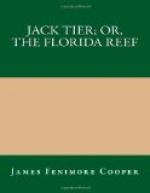The men were now called from the brig and ordered to come on board the schooner. Spike ascertained by actual measurement how much was wanted to bring the coamings of the main-hatch above the water, until which, he knew, pumping and bailing would be useless. He found it was quite an inch, and was at a great loss to know how that inch should be obtained. Mulford advised another trial with the handspikes and bars, but to this Spike would not consent. He believed that the masts of the brig had already as much pressure on them as they would bear. The mate next proposed getting the main boom off the vessel, and to lighten the craft by cutting away her bowsprit and masts. The captain was well enough disposed to do this, but he doubted whether it would meet with the approbation of “Don Wan,” who was still ashore with Rose and her aunt, and who probably looked forward to recovering his gunpowder by means of those very spars. At length the carpenter hit upon a plan that was adopted.
This plan was very simple, though it had its own ingenuity. It will be remembered that water could now only enter the vessel’s hold at the main-hatch, all the other hatchways having their coamings above the element. The carpenter proposed, therefore, that the main-hatches, which had been off when the tornado occurred, but which had been found on deck when the vessel righted, should now be put on, oakum being first laid along in their rabbetings, and that the cracks should be stuffed with additional oakum, to exclude as much water as possible. He thought that two or three men, by using caulking irons for ten minutes, would make the hatch-way so tight that very little water would penetrate. While this was doing, he himself would bore as many holes forward and aft as he could, with a two inch auger, out of which the water then in the vessel would be certain to run. Spike was delighted with this project, and gave the necessary orders on the spot.




